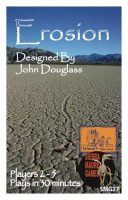
Erosion
The game consists of three types of cards with a process and a rock type. These cards are:
1. Weathering (WX cards)/Soft Rocks
2. Hillslope (H cards)/Medium Hard Rocks
3. Fluvial (F cards)/Hard Rock
Each deck also has two corresponding Atmosphere Cards (major events) which control how many cards can be drawn from each deck during a turn.
You start the game by shuffling each deck and putting them, face down, on the appropriate atmosphere cards (setting the initial draw limit of two cards per deck). Next, each player (starting player determined randomly) builds his starting mountain using 3 WX cards, 2 H cards and 1 F card randomly drawn, shuffled together, then laid out face up in a column with just the rock part of the card showing. He then gets six cards for his starting hand (again 3 WX, 2H and 1F card).
Each card of your mountain represents 500 metres of rock so you start out with a 3000 metre mountain. The top card is offset to the left of the other cards to indicate that it is weathered. Then, each player (starting with the start player) can do one of four actions. Each type of card you play (Weathering, Hillslope or Fluvial) has a different effect on the game or you can pass.
Weathering (WX) cards cause opponents’ rock cards to become weathered. Different weathering processes affect different types of rock and some can only affect rocks under certain heights. Weathered cards negate any special effect on the cards and means they can be affected by Hillslope cards.
Hillslope (H) cards move the rock from a mountain to a common area called the river where the rocks are sorted by type.
Fluvial (F) cards allow a player (by discarding the card plus cards from his hand with the same rock type as ones in the river – the number varies) to claim these cards and put them in his personal “delta” for scoring at the end of the round (era). For each card you weather or hillslope, you get to draw cards from the deck back to your six card maximum. Any number of cards in excess of this maximum you get to add to your mountain from cards in your hand in order to build it up (uplift it). For example, if you had weathered four cards in a mountain and you already had four cards in your hand, you would draw two cards into your hand and put two cards into your mountain using the rock portion of the card.
The round ends when either all players pass or one player passes twice and one of the decks runs out. You get one point for each unweathered rock in your mountain, two points for each rock in your delta and three points for each weathered rock still on your mountain which has a fossil symbol. If two people tie, the unusual tie-breaker is drawing a card from one of the decks unseen, then trying to guess its hardness on the Mohs hardness scale of 1-10. The person who guesses closest to the actual hardness wins the game. (The hardness of the various rocks is listed in the rules.) This tie-breaker is a little different than what we are used to but I’m OK with it.
The only difference between the basic and advanced game is that, in the advanced game, the special effects on some of the cards come into effect. The special effects allow one to perform special actions when the cards are used in uplift. These effects remain in effect until the card is “weathered”. They can also allow one to change the atmosphere cards, reducing the number of cards that can be drawn from certain decks.
The primary strategy of Erosion is balancing your attacks on the opponents’ mountains using the Weathering and Huillslope cards with playing Fluvial cards from the river in order to get points for the end of the round. I would suggest playing with the advanced rules since they add to the theme and make the game more interesting.
The production of the cards is good, the rules easy to understand and read. The only complaint is the game container which is a little flimsy and might pop open if you drop it.
Overall, Erosion is a fun, easy to learn game with lots of theme and one that is educational at the same time. You will learn more about geological erosive processes by playing a few games than you would get from a Geology 101 course. So if you have 30 to 45 minutes, this is a worthwhile game to check out.
User Reviews (0)
Add a Review for "Erosion"
You must be logged in to add a review.

Be the First to Add a Review!